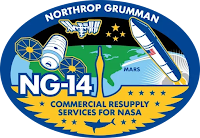Northrop Grumman - Cygnus NG-14 Mission patch.
October 2, 2020
Oct. 2 has been set for the launch of Northrop Grumman’s Antares rocket and Cygnus cargo spacecraft from the Mid-Atlantic Regional Spaceport at NASA’s Wallops Flight Facility near Chincoteague Island in Virginia.
The five-minute launch window opens at 9:16 p.m. EDT. Live coverage of the launch will air on NASA TV and at https://www.nasa.gov/live beginning at 8:45 p.m. EDT.
The launch may be visible, weather permitting and depending on other local conditions (such as elevation), to residents up and down the East Coast of the United States.
Image above: A Northrop Grumman Antares rocket carrying a Cygnus resupply spacecraft is seen on the Mid-Atlantic Regional Spaceport’s Pad-0A, Thursday, October 1, 2020, at NASA’s Wallops Flight Facility in Virginia. Northrop Grumman’s 14th contracted cargo resupply mission with NASA to the International Space Station will deliver nearly 8,000 pounds of science and research, crew supplies and vehicle hardware to the orbital laboratory and its crew. The CRS-14 Cygnus spacecraft is named after the first female astronaut of Indian descent, Kalpana Chawla, and is scheduled to launch at 9:38 p.m., Thursday, October 1, 2020 EDT. Photo Credit: NASA Wallops/Patrick Black.
An Oct. 1 attempt was scrubbed at roughly 2 minutes, 40 seconds prior to liftoff mark due to a problem with ground support equipment that has since been resolved.
Cygnus is loaded with nearly 8,000 pounds of cargo for the International Space Station. A liftoff on Oct. 2 would mean a scheduled arrival at the space station on Monday, Oct. 5.
Related article:
Launch of Northrop Grumman’s Antares rocket carrying a Cygnus spacecraft Scrubbed
https://orbiterchspacenews.blogspot.com/2020/10/launch-of-northrop-grummans-antares.html
Related link:
International Space Station (ISS): https://www.nasa.gov/mission_pages/station/main/index.html
Image (mentioned), Text, Credits: NASA/Rob Garner.
Best regards, Orbiter.ch


